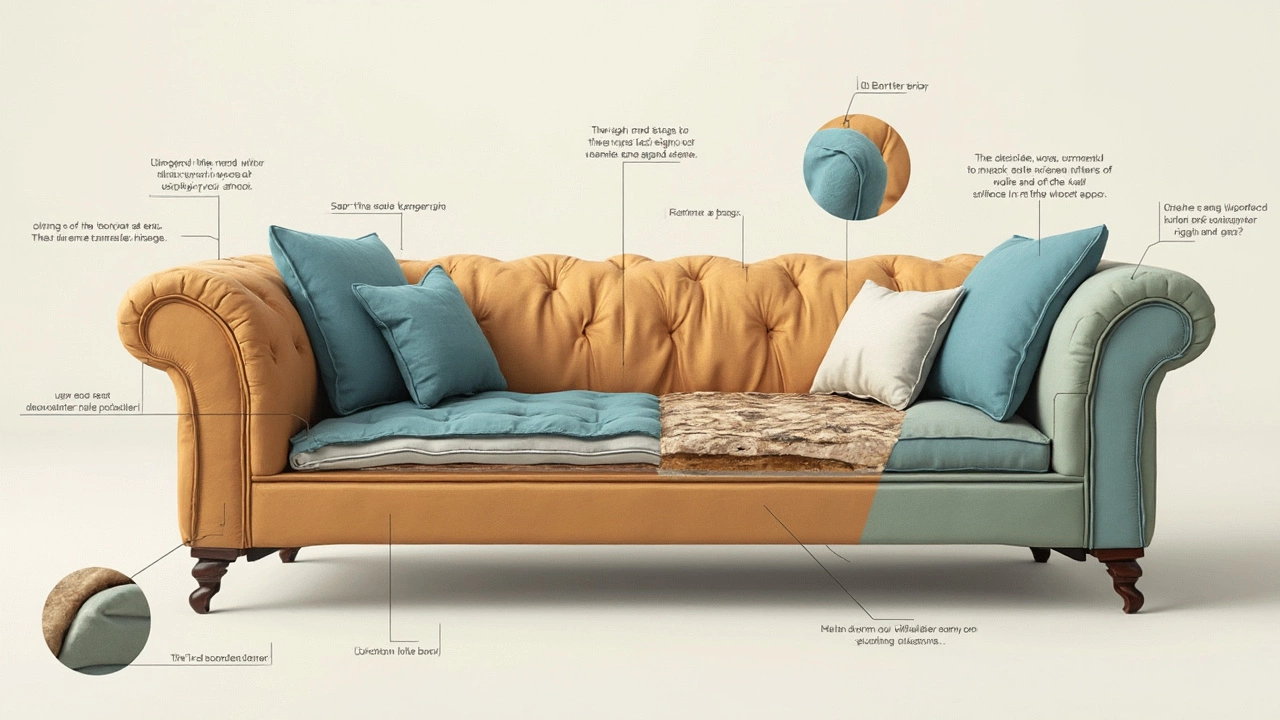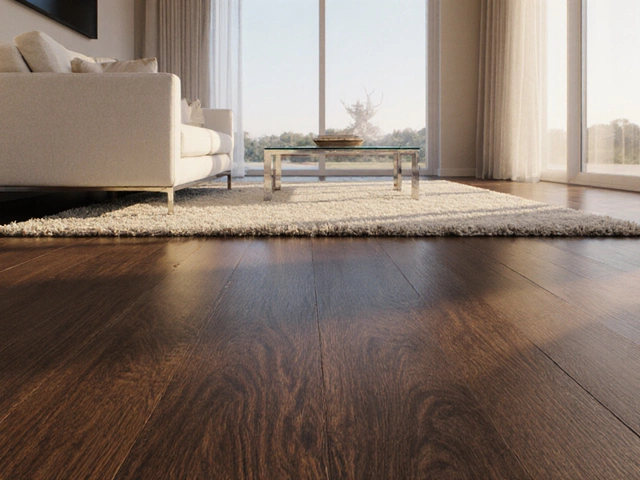
You probably don’t think about your couch’s lifespan until it sinks in the middle or squeaks every time you sit down. Here’s the truth: most couches stick around for 7 to 15 years, depending on what they’re made of and how much action they see. Leather usually hangs in there longer than a cheap fabric one, but usage is just as important as materials. If three kids and a dog claim it as their kingdom, expect more rapid wear and tear.
Before you hit that buy button or drag another sofa into your living room, it helps to know what to realistically expect. Not all couches are built equal, and sometimes, spending a bit more upfront saves you money and headaches later. Ignore the hype about ‘lifetime pieces’ if you’re not ready for spot cleaning every week or babying fragile fabric. The lifespan of your couch is really a mix of what it’s made from, daily abuse, and whether you ignore or actually follow care tips (hint: vacuuming cushions does make a difference).
- Typical Lifespan: The Numbers You Need
- Why Some Couches Last Years—And Others Don’t
- How to Tell When Your Couch Is Done
- How Much Does Quality Matter?
- Care Tricks: Making Your Couch Last Longer
- When to Repair, Replace, or Upgrade
Typical Lifespan: The Numbers You Need
Most people want to know how long their couch should stick around, but the answer totally depends on what you’ve got. Here’s the quick summary: the average sofa lasts anywhere from 7 to 15 years. That’s if you use it regularly but don’t do wild stuff like jump on it every night.
If you get a lower-end fabric piece, expect it to last closer to 7 years before saggy cushions or torn upholstery show up. Mid-range and quality leather sofa sets can go 12 to even 20 years. But don’t just take my word for it—Consumer Reports says,
"The best quality couches last about 15 years, while bargain pieces might get you five at best. You can expect moderate quality sofas to hold up for 7 to 10 years."
Here’s how typical lifespans shake out based on type and use:
| Type of Couch | Expected Lifespan |
|---|---|
| Budget fabric sofa | 5-8 years |
| Mid-range fabric sofa | 8-12 years |
| Quality leather sofa | 12-20 years |
| Sofa bed/futon | 4-7 years |
Another tip: how often you use your couch matters a lot. Something in a formal living room that only hosts guests on holidays might outlast your family room sofa by a mile. And if you’ve got pets or kids, well, you know the drill—scratches, spills, and cushion squashing speed things up.
If you’re shopping for a new one, pay attention to frame material (solid hardwood lasts longer than particle board), quality foam, and tough fabric. These factors boost your couch lifespan way more than you’d expect.
Why Some Couches Last Years—And Others Don’t
So, why does your friend’s old couch from college still look half-decent, but your two-year-old sofa is already sinking in? It’s all about what’s under the cushions, plus how the whole thing is put together. When it comes to couch lifespan and sofa durability, looking at the inside tells you more than fancy showroom pictures ever will.
The real winners are usually made with hardwood frames—think oak, maple, or ash—because they don’t bend or crack easily. Cheaper couches often use plywood or even particleboard, which can start warping within a couple of years. Joints matter too. Strong ones are glued, screwed, and sometimes even have wooden dowels. If the manufacturer just stapled some boards together, don’t expect that couch to survive much roughhousing.
Let’s talk about cushions next. High-density foam (look for numbers like 1.8 or higher) will bounce back and hold its shape. Cheaper foam flattens in no time. And if you want a super comfy option, a mix of foam plus a pocket of down or polyester gives you the best of both worlds.
- Leather usually lasts longer than fabric because it resists stains and ripping, but it does need some conditioning so it won’t crack over years.
- Performance fabrics (like microfiber or treated polyester) stand up to kids, dogs, and “Netflix and spill” nights way better than delicate linen or silk.
- Removable, washable cushion covers are not just for looks—they actually help keep couches around longer since you can ditch the dirt and oils that wear down fibers.
Couch price can show you something, too. Most sofas under $350 (unless on a deep sale) cut corners somewhere, and the sofa durability isn’t going to compare to a $900+ mid-range piece with solid wood and better foam inside.
Here’s a quick breakdown of why some sofas outlive the others:
| Feature | Long-Lasting Sofa | Short-Lived Sofa |
|---|---|---|
| Frame Material | Hardwood | Plywood or Particleboard |
| Cushion Fill | High-density foam or foam + down | Low-density foam |
| Fabric | Leather / Performance Fabric | Linen, Silk, Cheap Polyester |
| Joint Construction | Glued & Screwed/Doweled | Stapled only |
| Price Range | $900 and up | $350 and below |
It’s not just what you buy, it’s how you treat it—but more on that later. Want a couch lifespan that actually justifies your investment? Check these key factors before you hand over your credit card.
How to Tell When Your Couch Is Done
If your couch lifespan feels like a mystery, there are clear warning signs that yours is past its prime. It’s not just about ugly fabric or a weird smell—though those matter. Start with how it feels. If you sit and basically sink to the frame, that’s a red flag. Foam and springs aren’t meant to last forever. Even high-end sofa sets will dip or sag eventually, especially in favorite spots.
Next up, check the back and arms for creaks or wobbling. Shaky parts mean the frame might be cracked or loose. With a cheap couch, particleboard frames split way before solid wood ones. And if you hear weird noises every time you sit down, don’t just blame the dog—those squeaks mean something’s not right inside.
Fabric is another giveaway. If it’s stained beyond saving, ripped, or even thinning out (you can see the padding), it’s time to admit defeat. Leather couches get cracked and flaky. For sofa durability, even small rips can get a lot bigger fast if you try to ignore them.
- Odors: If your couch smells funky no matter how much you clean, it’s probably soaked into the padding. Not worth the struggle.
- Cushion Shape: Misshapen cushions that don’t bounce back aren’t just ugly—they’re uncomfortable too.
- Noisy Springs: Persistent creaks or pops? Springs or inner supports are breaking down.
- Wobbly Legs or Frame: A solid frame shouldn’t move when you plop down. If it does, you’re pushing your luck with safety.
Here’s a quick way to spot the most obvious issues at a glance:
| Sign | What It Means |
|---|---|
| Deep Sags | Support is gone; major wear to cushions or springs |
| Creaking Noises | Frame or springs have loosened or broken |
| Visible Stains/Rips | Fabric beyond simple cleaning or patching |
| Stubborn Smells | Inside cushioning is dirty or moldy |
If these issues add up, your couch lifespan is over. Hanging on just makes your living room uncomfortable—and honestly, a little sad. Sometimes, letting go is the smartest choice.

How Much Does Quality Matter?
If you want your couch to last beyond movie night snacks and late-night naps, quality is a big deal. Think about it: a $300 couch from a big-box store won’t last as long as a $1,500 sofa built with hardwood frames and dense foam. The gap isn’t just about looking nicer. It’s about what’s on the inside—literally.
Most couch lifespan differences start with the frame. Hardwood (like oak, maple, or ash) seriously outlasts plywood or particleboard. Joints joined with dowels or screws handle years of shifting weight better than staples or glue. The next thing that matters is what you actually sit on. High-density foam holds its shape longer and won’t flatten like cheaper low-density stuffing. Pocket coils (yes, like a mattress) stand up to heavy use compared to just foam and fabric alone.
Fabric is another game-changer for sofa durability. Top-grain leather laughs off most spills and pets; microfiber resists stains better than natural linen or cotton. One well-known stat: microfiber couches can last up to 10 years, leather even longer—if you take care of them. If you’re about to pick a bright velvet that looks cool but frays in a year, think again.
| Type of Couch | Frame Material | Average Lifespan |
|---|---|---|
| Budget Sofa | Plywood/Particleboard | 3–5 years |
| Mid-range Sofa | Mixed Wood/Metal | 7–10 years |
| High-End Sofa | Solid Hardwood | 12–20 years |
So, is it worth paying more? If you plan on keeping your sofa set for years, yes. But if you’re moving often or need something for a short time, budget options can do the trick—just don’t expect miracles. The next time a sales rep promises you “forever quality” for the price of a pizza, you’ll know what questions to ask about frame and cushions. A little research means a way better seat for the long haul.
Care Tricks: Making Your Couch Last Longer
Want your couch lifespan to hit the double digits? It’s way more about care than luck. Any sofa will wear out faster if you treat it like a trampoline or let crumbs burrow deep. But a few simple habits will stretch those years and keep your place looking good.
- Vacuum Weekly: Dust and dirt act like sandpaper and wear down the fabric and seams. Regular vacuuming, including under the cushions, can add years. Use a soft brush attachment for best results.
- Flip and Rotate Cushions: Not all couches have loose cushions, but if yours do, turn them and swap their spots every couple of weeks. It spreads out the pressure, keeping them from flattening or sagging.
- Spot Clean Spills Fast: The faster you tackle stains, the less likely they’ll set in. Check your sofa’s care tag and use fabric-friendly cleaners. Water may actually make some stains worse, so always blot first—never rub.
- Keep Direct Sun Off: Prolonged sunlight fades fabric or dries out leather, making it crack. Try to keep your couch out of those sunbeam sweet spots or use a throw when you’re not using it.
- No Jumping Zone: Letting kids (or pets) jump on the sofa does a number on the frame and springs. Friendly reminder signs help, but you may also want to get a play mat for the floor.
- Use Armrest and Seat Covers: These high-touch areas wear first. Covers absorb the damage and are way easier to clean or swap out than reupholstering the whole sofa.
If you’re into numbers, here’s how much good care can stretch your sofa durability:
| Condition | Typical Lifespan |
|---|---|
| Heavy Use, No Care | 5-7 Years |
| Average Use, Occasional Care | 8-10 Years |
| Regular Care (Tips Above) | 12-15 Years |
One last thing—keep your receipts and any care instructions. Some warranties are only valid if you follow the manufacturer’s cleaning recommendations. Staying on top of little things now makes a big difference in how long you’ll sit comfortably on that sofa without thinking about replacing it.
When to Repair, Replace, or Upgrade
It’s tough to know when to call it quits on your couch lifespan. But there are some clear signs and things to consider that make the decision easier. You want your place to feel comfortable and look good, but you don’t want to spend money when you don't have to.
Here’s when a repair might do the trick:
- Cushions are sagging, but the frame’s still solid. A foam or cushion swap can make your sofa durability bounce back.
- Fabric’s stained, ripped, or just ugly—many covers can be replaced or deep-cleaned. DIY slipcovers are an easy fix.
- Minor squeaks or loose screws can be handled with simple tools and a little time.
Now, when should you consider replacing the whole thing?
- The frame is cracked, warped, or creaks even after repairs. Safety comes first.
- You can feel springs poking through, or the support is totally gone.
- Upholstery is torn beyond repair, or you get a certain musty smell that won’t quit. Sometimes things are just too far gone.
An upgrade can be about more than necessity, too. Lots of people replace their couch just to refresh the style or size—a sofa set that fit when you first moved in might not match your life now.
Want some real-world numbers? Households in the U.S. tend to replace their sofa sets every 8-10 years, according to furniture industry stats. But if you baby your sofa (think no eating, easy on the pets), it’s possible to get a few more years before you have to let go.
| Repair | Replace | Upgrade |
|---|---|---|
| Cushion swap | Broken frame | Bigger size |
| Clean/replace covers | Painful springs | Modern style |
| Tighten hardware | Severe smells/mold | Better features (sleepers, recliners) |
If you do replace, don’t just toss your old couch on the curb. Many communities offer donation or recycling programs, which is way better for the planet.
Bottom line: listen to your couch. A quick fix might save you money, but holding on too long just kicks the problem down the road. Sometimes, a fresh start is worth every penny.



